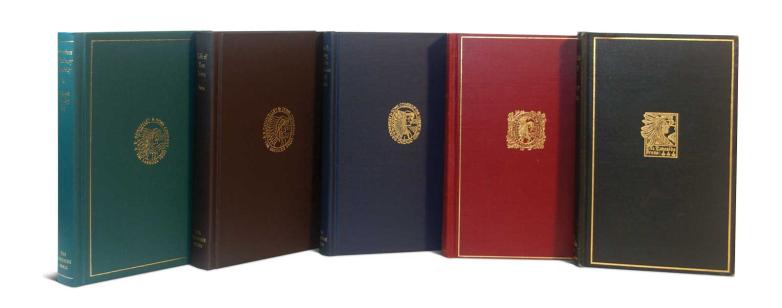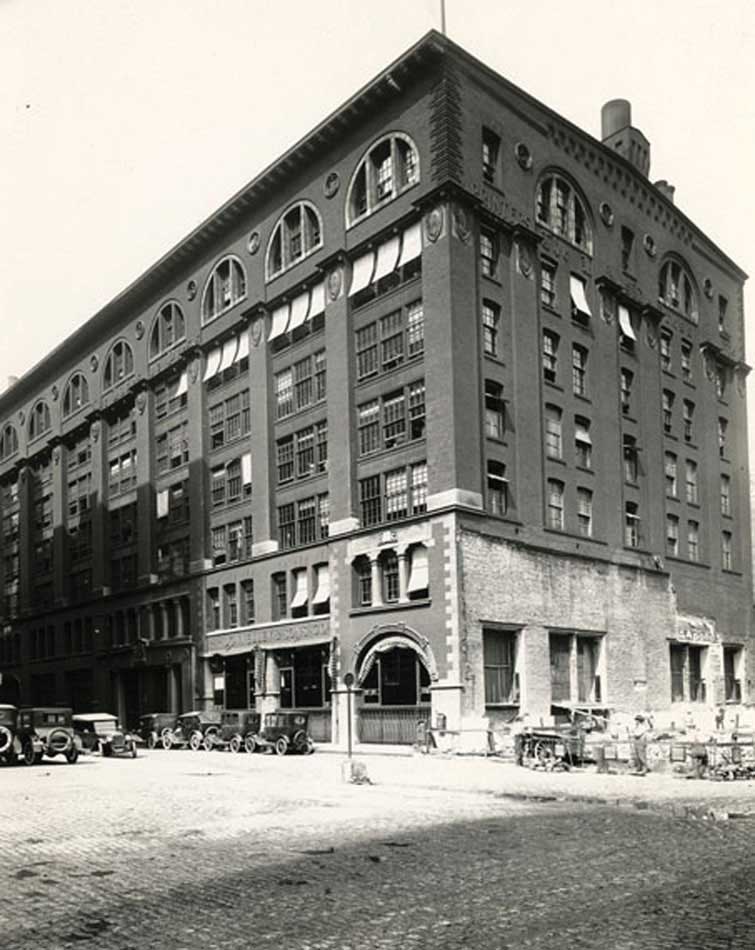Subject matter isn’t the only consistency that identifies the Classics series, however. The physical appearance of the books hasn’t changed much over time either—with one exception. Every twenty-five years or so, the cover of the binding changes color.
“The earliest books had green covers and are sometimes referred to as ‘the greenies,’” explained John Townsend, an Americana specialist and owner of Town’s End Books in Deep River, Connecticut (townsendbooks.com). The greenies refer to volumes published from 1903 to 1927. From 1928 to 1952, the covers changed to red, then to dark blue from 1953 to 1977. The next twenty-four years, from 1978 to 2002, the Classics had a dark brown cover, then in 2003 the cover changed to turquoise to mark the 101st year of the series. All the books have gilt text stamping on the spine and the front boards feature that year’s current seal for Lakeside Press. Fitzgerald said the color-coding helps to create a subset category of collectors. “One might, for example, work on collecting the browns and then the blues and so on,” he said.
The dealers agreed that collectors of Lakeside Classics are a varied bunch because the books appeal on so many different levels. “Anyone who is interested in American history, folklore, or the development of the U.S. would be interested in these books,” said Townsend. But there are other motives for collecting the Classics series. “People who had a relative working for Donnelley and who passed on the books may want to continue collecting the series.” That leads to the classic collector’s dilemma. “Once someone starts collecting the series, they don’t want to stop.” Old West collectors, and collectors of Lincoln, the presidents, explorers, and the Civil War will also find something of interest in the series, be it Kit Carson’s Autobiography (1935) or Two Views of Gettysburg by Sir. A. J. L. Fremantle and Frank Haskell (1964).
The Lakeside Classics are relatively easy to find, particularly the later ones. Although the distribution is limited, the books find their way to shops, dealers, and auction sites. They also make the occasional appearance at garage sales and flea markets. Another way to acquire them is by buying current copies direct from Donnelley employees. “Before Donnelley closed the nearby plant, I had regular customers who sold me their copies every year,” said Townsend.
While Donnelley is mum on the number of Classics printed each year, book dealers have their own rough estimates. Townsend said he asked Levy several years ago how many books would be printed that year, and the response was 40,000. “The number surprised me,” he said. “I thought it would be smaller.”
It explains why the later books in the series are more available (and less valuable), though Townsend said he doesn’t sell any Lakeside Classic for less than $20. “Lately, Donnelley has closed plants so the press run may be going down,” he said. “That means the books published now may climb in value since there will be fewer of them.”
The most valuable Lakeside Classics are the early greenies. “They sell for about $300 each,” said Gargani. There are, however, a couple of notable exceptions. “The 1904 book is pretty rare,” he added, perhaps because Inaugural Addresses of the Presidents of the United States from Washington to Lincoln has become popular with Lincoln collectors.
But the Lakeside Classic most difficult to track down, according to both dealers, is the title printed in 1906, Fruits of Solitude by William Penn. The subject matter, while appealing, is not the price driver. “There weren’t many copies of the book produced,” said Gargani—only about six hundred copies. “And it was a slim volume,” Townsend said. He guessed that some copies may have been mistakenly discarded. That volume is currently worth about $3,000.
As the series began to find its way onto the open market, public demand grew—but Donnelley, in all its years of publishing the books, has never once sold any of them. “Books are traditionally given to customers, company retirees who were familiar with the tradition, to employees in countries where the English-language books centered on American history will be of interest, and to shareholders who request them,” said Fitzgerald.
Donnelley, of course, has a complete set of the books. “They’re displayed in a small library at the company’s corporate headquarters in Chicago,” said Fitzgerald.
The Classics series has always had a limited distribution, but there was a brief time when Donnelley agreed to make the first five books of the series more available. Reports indicated that one thousand copies of the 1903 edition were produced, but from 1904 through 1910, the number of copies printed dropped to six hundred. That meant not everyone who wanted a copy received one, said Gargani. Consequently, Donnelley agreed to have those five volumes reprinted under the Reilly & Britton Company imprint. The reprints, known as the Patriotic Classics, were released in the early- to mid-1900s, shortly after the early Lakeside Classics were printed. While Townsend noted that the reprints aren’t as desirable as the originals in the series, they are becoming increasingly difficult to find. “In some cases, they can be even harder to find than the original Classics,” said Gargani, “because not many of them were produced.” Townsend tells clients that if they want to collect the Lakeside Classics series, it’s better to have all the original Classics. “But they can always buy the Patriotic Classics as a placeholder for the original volume until they can afford or are able to locate a copy,” he added.
As a side note—and to avoid confusion—R. R. Donnelley has also reprinted other classic books under The Lakeside Library imprint. These books, said Gargani, are rare books that the company collected and then reproduced. The best-known book in this series may be the 1930 printing of Moby Dick illustrated by Rockwell Kent. The book came as a set of three volumes inside a slipcase and is sometimes referred to as “Moby Dick, The White Whale in a Can.” According to company reports, only one thousand copies of the three-volume edition were produced. (Gargani shows a copy of it on his website, listed at $7,950.) A second version of Moby Dick was also printed that year, by Random House, as one volume.
In 2002, when the one-hundredth volume of the Lakeside Classics, Narrative of the Coronado Expedition, was distributed, there was a general feeling that the book would be the end of the series. “We never know from year to year if the company will continue the Classics,” Townsend said. “With the one-hundredth volume, we thought this might be it.”
But in 2003, Donnelley released The Rough Riders by Theodore Roosevelt on schedule. Gargani insisted he doesn’t believe the company would give up on the Classics. “It’s the legacy of Thomas Donnelley,” he pointed out.
“R. R. Donnelley continually works to answer our first mission,” said Fitzgerald. “That’s delivering value to our shareholders.” Within that context, he said, a 2010 volume of the Lakeside Classics—Travels Through South Carolina, Georgia & Florida by William Bartram—was once again distributed this past December. And, he added, “The topic and texts have been selected for 2011.”



















